Takotsubo cardiomyopathy in a healthy twenty year old
by Mark Abela & Herbert Felice
Introduction
Takotsubo cardiomyopathy, also known as Transient apical ballooning syndrome, stress-induced cardiomyopathy and broken-heart-syndrome, is a rare non-ischemic cardiomyopathy that presents as an acute coronary syndrome without evidence of obstructive atherosclerotic coronary disease. Its name is derived from the Japanese Takotsubo – an octopus trap, resembling the elliptical shape of the very typical akinetic left ventricular apex during systole on imaging studies.1 It is nowadays increasingly recognized as a new disease entity when faced with normal coronary arteries on angiography with the very typical left ventriculogram, often presenting with acute heart failure, arrhythmias or rarely ventricular rupture.2
Case presentation
A 20 previously healthy year old female (including no known drug allergies) presented for an elective breast lumpectomy. After anaesthetic induction, the patient suddenly experienced a twenty second interval of wide complex irregular tachycardia associated with unrecordable blood pressure. The patient was urgently intubated and resuscitated. There was clinical pulmonary edema present. Blood gases revealed metabolic acidosis with severe hypoxia, despite a high oxygen flow rate. An urgent echocardiogram was done which showed ventricular dilatation with apical and anteroseptal hypokinesia. The atria were normal and the base was spared.
Once in the Intensive Care Unit, inotropes and fluids were given to improve blood pressure and oxygen saturation. The patient was kept sedated with 3mg of midazolam and morphine. The electrocardiogram revealed sinus tachycardia with early onset left bundle branch block with absent elevations in creatinine kinase and troponins.
An echocardiogram on the fifth day (after the acute event) showed normal left ventricular dimensions, global and regional contractility with an ejection fraction of 61%. The patient’s parameters eventually normalised and she was discharged home on an angiotensin converting enzyme (ACE) inhibitor and advised to limit physical activity for the next few weeks. A scheduled coronary angiogram was refused by the patient. A review echocardiogram at outpatients was organised at one and three months post-discharge.
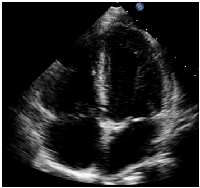
ECHO 1: Four chamber view in systole (Acute phase ‘Day 0’)
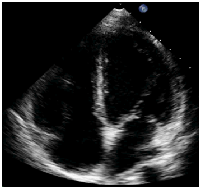
ECHO 2: Four chamber view in diastole (Acute phase ‘Day 0’)
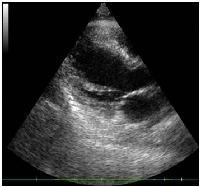
ECHO 3: Four chamber view in systole (Recovery phase ‘Day 5’)
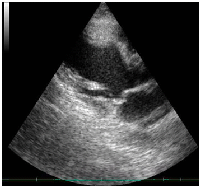
ECHO 4: Four chamber view in diastole (Recovery phase ‘Day 5’)
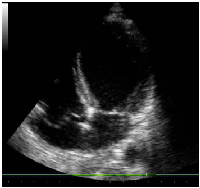
ECHO 5: Parasternal long axis view in systole (Acute phase ‘Day 0’)
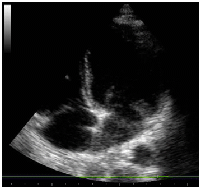
ECHO 6: Parasternal long axis view in diastole (Acute phase ‘Day 0’)
Discussion
Aetiology and Pathogenesis
A variety of psychological and physiological stressors (including anaesthesia) have been implicated in the literature, with one study revealing that such precipitants were present in 61% of cases.3 Two major pathogenic mechanisms have been proposed: a) catecholamine cardiotoxicity as a primary or secondary phenomenon2 and b) neurogenic stunned myocardium causing epicardial coronary arterial spasm as a result of an exaggerated sympathetic response.2,4,5
Focal myocytolysis is consistently present in myocardial histology, characteristically absent in myocardial infarction.6 In addition, biopsies also often display contraction band necrosis, though the catecholamine-mediated myocardial stunning causing the insult is not consistent. 7-9,10
More evidence for an exaggerated sympathetic response has emerged from studies in ovariectomised female rats in which the syndrome of local apical ballooning provoked by restraining stress could be prevented by β-blockade and attenuated by oestrogen suppletion.11 However, considering the duration of akinesia and the multivessel coronary spasm required for such an extensive apical wall abnormality, conventional coronary vasospasm due to sympathetic over-response seems inprobable.6
The apical myocardium manifestations could be explained by its high vulnerability towards adrenergic aggression,12 a statement consistent with similar wall abnormalities observed in phaeochromocytoma-related cardiomyopathy.13 However, recently several other forms (Types I-V) of stress-induced cardiomyopathy have been described.14-16
Epidemiologically
The syndrome has a higher preponderance for the female gender in the over sixties, with estrogen possibly playing a role.17,18 Reports in children and young adults have also been reported.19,20 A genetic role might also be possible after an isolated report described the disease in two sisters.21
Clinical Features and Investigations
The patient’s presentations are very non-specific, with sudden onset of symptoms resembling an acute STEMI, with or without cardiogenic shock and arrythmias.1 The Mayo Clinic have drafted up four major criteria which have to be present in order to diagnose Takotsubo cardiomyopathy.22
Table 1: Mayo Clinic major criteria for diagnosing Takotsubo cardiomyopathy
Major Criteria
- On echocardiography/ventriculogram, transient dyskinesis/akinesis of the left ventricular mid-segments with or without apical involvement with no single arterial territory involved, with or without a stressful trigger and accompanied with a massive decrease in left ventricular ejection fraction22
- Absence of obstructive coronary disease or angiographic evidence of acute plaque rupture22
- New electrocardiographic abnormalities
ST-segment elevation and/or T-Wave inversion22
OR
Modest elevations in cardiac troponins22
- Absence of phaeochromotycoma or myocarditis22
Interestingly, a number of cases have been reported that are similar in presentation to Takotsubo cardiomyopathy but do not however manifest the typical elliptical shape of the left ventricular apex, a presentation described as an ‘inverted Takotsbo’.16,23
Management
The specific treatment of the condition is still largely empirical due to the limited availability of controlled data. Drugs including diuretics, ß-blockers such as carvedilol, and ACE inhibitors are often used until recovery of LV function, with no evidence available for their use after recovery. Most importantly, anti-platelets should be considered until a thrombotic pathogenesis is excluded, during the apical akinesis or dyskinesis interval to resolve the cardioembolic risk. Some physicians also consider inotropes or intra-aortic balloon counterpulsation, with the latter being the preferred option due to the potential role of catecholamine excess in the pathogenesis. Follow-up echocardiographic evaluation is routinely performed to ensure resolution of the left ventricular dysfunction and improvement in the ejection fraction.24,25
Prognosis
Although the prognosis for most patients with this syndrome is favorable, with complete recovery of ventricular function within 1 to 4 weeks, several cases of fatal outcomes have been reported.17,26 The evolution, although mainly uneventful, can be complicated, rarely, by left ventricular rupture and ventricular tachycardia, possibly causing sudden death. The recurrence of this syndrome seems to be rare.1
Conclusion
The incidence of “broken heart syndrome” has not as yet been ascertained with the prevalence likely to be under-estimated because of the low level of awareness and infrequent diagnosis. It is nowadays been increasingly recognized in clinical practice which is why more research is needed to determine the exact pathogenesis, increase awareness and optimize management of the syndrome, especially in the acute setting, and identify those subjects prone to this potentially lethal condition.
References
1.Khallafi H, Chacko V, Varveralis N and Elmi F. “Broken Heart Syndrome”: Catecholamine Surge or Aborted Myocardial Infarction? The Journal of Invasive Cardiology.2008;20(1):E9-E13.
2.Akashi YJ, Nef HM, Möllmann H and Ueyama T. Stress Cardiomyopathy. Annual Review of Medicine. 2010; 61:271-286.
3.Eshtehardi P, Koestner SC, Adorjan P, Windecker S, Meier B, Hess OM, Wahl A and Cook S. Transient apical ballooning syndrome — clinical characteristics, ballooning pattern, and long-term follow-up in a Swiss population. International Journal of Cardiology. 2009. Volume 135, Issue 3, Pages 370-375 (10 July 2009)
4.Lacy CR, Contrada RJ, Robbins ML, et al. Coronary vasoconstriction induced by mental stress (simulated public speaking). Am J Cardiol 1995;75:503-505.
5.Owa M, Aizawa K, Urasawa N, et al. Emotional stress-induced ampulla cardiomyopathy: Discrepancy between the metabolic and sympathetic innervation imaging performed during the recovery course. Jpn Circ J 2001;65:349-352.
6.Virani SS, Khan AN, Mendoza CE, Ferreira AC and Marchena E. Takotsubo Cardiomyopathy, or BrokenHeart Syndrome. Texas Heart Institute Journal. 2007; 34:76-9
7.Bybee KA, Prasad A, Barsness GW, et al. Clinical characteristics and thrombolysis in myocardial infarction frame counts in women with transient left ventricular apical ballooning syndrome. Am J Cardiol 2004;94:343-346.
8.Clarke JG, Davies GJ, Kerwin R, et al. Coronary artery infusion of neuropeptide Y in patients with angina pectoris. Lancet 1987;1:1057-1059.
9.Mann DL, Kent RL, Parsons B, Cooper G. Adrenergic effects on the biology of the adult mammalian cardiocyte. Circulation 1992;85:790-804.
10.Singal PK, Kapur N, Dhillon KS, et al. Role of free radicals in catecholamineinduced cardiomyopathy. Can J Physiol Pharmacol 1982;60:1390-1397.
11.Mori H, Ishikawa S, Kojima S, Hayashi J, Watanabe Y, Hoffman JI, et al. Increased responsiveness of left ventricular apical myocardium to adrenergic stimuli. Cardiovasc Res 1993;27:192-8.
12.Gianni M, Dentali F, Grandi AM, Sumner G, Hiralal R, Lonn E. Apical ballooning syndrome of takotsubo cardiomyopathy: a systematic review. Eur Heart J 2006;27:1523-9.
13.Reuss CS, Lester SJ, Hurst RT, Askew JW, Nager P, Lusk J, et al. Isolated left ventricular Basal ballooning phenotype of transient cardiomyopathy in young women. Am J Cardiology 2007;99: 1451-3.
14.Steen H, Merten C, Katus HA, Giannitsis E. Images in cardiovascular medicine. A rare form of midventricular Tako-Tsubo after emotional stress followed up with magnetic resonance imaging. Circulation 2006;114:e248.
15.Abdulla I, Kay S, Mussap C, Nelson GI, Rasmussen HH, Hansen PS, et al. Apical sparing in Tako-Tsubo cardiomyopathy. Intern Med J 2006;36:414-8.
16.Reeder GS. Stress-induced (Tako-Tsubo) cardiomyopathy. Mayo Foundation. April 2007.
17.Sharkey SW, Lesser JR, Zenovich AG, et al. Acute and reversible cardiomyopathy provoked by stress in women from the United States. Circulation 2005;111:472-479.
18.Gianni M, Dentali F, Grandi AM, et al. Apical ballooning syndrome or takotsubo cardiomyopathy: A systematic review. Eur Heart J 2006;27:1523.
19.Wittstein IS, Thiemann DR, Lima JAC, et al. Neurohumoral features of myocardial stunning due to sudden emotional stress. New Engl Med 2005;352:539.
20.Kurisu S, Sato H, Kawagoe T, et al. Tako-tsubo-like left ventricular dysfunction with ST-segment elevation: A novel cardiac syndrome mimicking acute myocardial infarction. Am Heart J 2002;143:448-455.
21.Pison L, De Vusser P, Mullens W. Apical ballooning in relatives. Br Med J 2004;90:e67.
22.Tsuchihashi K, Ueshima K, Uchida T, et al. Transient left ventricular apical ballooning without coronary artery stenosis: A novel heart syndrome mimicking acute myocardial infarction. J Am Coll Cardiol 2001;38:11-18.
23.Sanchez-Recalde A, Costero O, Oliver JM, et al. Pheochromocytoma-related cardiomyopathy inverted t akotsubo contractile pattern. Circulation 2006;113:e738-739.
24.The Broken Heart Syndrome. Cleve Clin J Med 2007; 74(supp 1):17-22.
25.Nykamp D and Titak JA. Takotsubo cardiomyopathy, or broken-heart syndrome. The annals of pharmacotherapy. 2010 Mar; 44(3):590-593.
26.Van de Walle SO, Gevaert SA, Gheeraert PJ, et al. Transient stress-induced cardiomyopathy with an” inverted takotsubo” contractile pattern. Mayo Clin Proc 2006;81:1499-1502.

